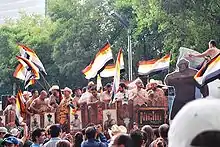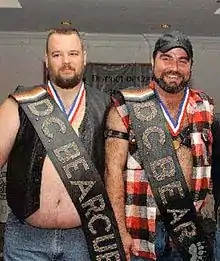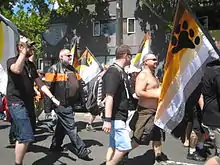Bear (gay culture)
In male gay culture, a bear is often a larger or obese hairier man who projects an image of rugged masculinity. Bears are one of the many LGBT communities with events, codes, and a culture-specific identity. However, in San Francisco during the 1970s, any hairy man of whatever shape was referred to as a 'bear' until the term was appropriated by larger men, and other words had to be used to describe hairy other-shaped men such as otter (slim), cub (young bear on the way), or wolf (hairy, medium build).[2] The word manatee describes a big, hairless man, i.e., a bear without hair.

The term bear was popularized by Richard Bulger, who, along with his then partner Chris Nelson (1960–2006), founded Bear Magazine in 1987. There is some contention surrounding whether Bulger originated the term and the subculture's conventions. George Mazzei wrote an article for The Advocate in 1979 called "Who's Who in the Zoo?",[3] that characterized gay men as seven types of animals, including bears.[4]
_Winners.jpg.webp)
The bear concept can function as an identity or an affiliation, and there is ongoing debate in bear communities about what constitutes a bear. Some bears place importance on presenting a clear masculine image and may disdain or shun men who exhibit effeminacy,[5] while others consider acceptance and inclusiveness of all behavioural types to be an important value of the community.[6]
The bear community consists primarily of gay or bisexual men. However, as LGBT culture and modern slang has taken on a wider appeal in modern society, it is possible to call a hairy and burly straight man a bear, although they would not be strictly part of the gay bear community.[7] Increasingly, those who shun labels for gender and sexuality are also included within bear communities.[8] However, heterosexual men who have bearish physical traits and are affirming of their gay friends and family (or their gay fans, in the case of a celebrity) may also be informally accorded "honorary" bear status.[9] A smaller number of lesbians, particularly those who are butch, also participate in bear culture, referring to themselves with the distinct label of ursula.[10]
History

In San Francisco in the 1970s, any hairy man of whatever shape was referred to as a 'bear' until the term was appropriated by larger men, and other words had to be used to describe hairy other-shaped men such as otter (slim), cub (young bear on the way), or wolf (hairy, medium build).[2] The word manatee describes a big, hairless man, i.e. a bear without hair.
The term bear was popularized by Richard Bulger, who, along with his then partner Chris Nelson (1960–2006), founded Bear Magazine in 1987. There is some contention surrounding whether Bulger originated the term and the subculture's conventions. George Mazzei wrote an article for The Advocate in 1979 called "Who's Who in the Zoo?",[3] that characterized gay men as seven types of animals, including bears.[4]
At the onset of the bear movement, some bears separated from the gay community at large, forming "bear clubs" to create social and sexual opportunities of their own. Many clubs are loosely organized social groups; others are modeled on leather biker-patch clubs, with a strict set of bylaws, membership requirements, and charities. Bear clubs often sponsor large yearly events – "bear runs" or "bear gatherings" like the annual events such as Southern HiBearNation in Melbourne, Bear Pride and Bear Essentials in Sydney, Bearstock in Adelaide, HiBearNation in St. Louis, Missouri, SF Bear Weekend, CBL's Bear Hunt,[11] Bear Pride in Chicago, Atlanta Bear Pride, Texas Bear Round Up (TBRU) in Dallas, Orlando Bear Bash,[12] and Bear Week in Provincetown (since 2001), drawing regional, national and international visitors. Many LGBT events attract a significant bear following, such as Southern Decadence[13] in New Orleans.
Jack Fritscher was the founding editor of San Francisco's California Action Guide (1982). With California Action Guide, Fritscher became the first editor to publish the word "Bear" (with the gay culture meaning) on a magazine cover (November 1982).[14] As well, with producer Mark Hemry in 1984, Fritscher co-founded the pioneering Palm Drive Video featuring homomasculine entertainment. Palm Drive Video expanded in 1996 to Palm Drive Publishing, San Francisco. For Palm Drive Fritscher wrote, cast, and directed more than 150 video features. His work includes documentary footage of the first bear contest (Pilsner Inn, February 1987). A bear contest is a feature at many bear events, a sort of masculine beauty pageant awarding titles and sashes (often made of leather) to winners. This footage is no longer for sale, as Fritscher declined to shift to DVD format and shut down the video company.

One example of a bear contest was International Mr. Bear, formerly held each February at the International Bear Rendezvous in San Francisco. It attracted contestants, often with local titles, from all over the world. The first International Mr. Bear was held in 1992, and the last was held in 2011. The contest included Bear, Daddy, Cub, and Grizzly titles with the contestant who received the highest score winning the bear title, regardless of what type he was. Example: "Mr. Washington, D.C. Bear, 2006". Gay "leather-bears" have competed in leather contests, and "muscle-bears" are another subculture noted by their muscular body mass.
The International Bear Brotherhood Flag is the pride flag of the bear community. Craig Byrnes created this flag in 1995.[1]
The bear community has spread all over the world, with bear clubs in many countries. Bear clubs often serve as social and sexual networks for their members, who can contribute to their local gay communities through fund-raising and other functions. Bear events have become very common, to include smaller sized cities and many rural areas. Most gay oriented campgrounds now include some type of bear-related event during their operating season.
The bear community constitutes a specialty niche in the commercial market. It offers T-shirts and other accessories as well as calendars and porn movies and magazines featuring bear icons, e.g., Jack Radcliffe. Catalina Video has a bear-themed line, the "Furry Features Series." Other adult studios who feature bear-type men are Bear Magazine, 100% BEEF Magazine, BearFilms, Bear, Butch Bear, Raging Stallion, and Titan Media. There are also social media websites and smartphone apps that market to men of the bear community.
As the bear community has matured, so has its music and literature, as well as other (non-pornographic) arts, media, and culture. Examples include Bearapalooza, a traveling bear music festival; Bear Bones Books, an imprint of LGBTQ publisher Lethe Press, which markets fiction, nonfiction, and poetry titles written by and for bears; BearRadio.net, which streams bear and LGBT music and bear-themed podcast shows. The larger organized bear runs often host a "bear market" area where artisans, musicians, and others offer items for sale.
As more gay men have identified themselves as bears, more bars, especially leather or western bars, have become bear-friendly. Some bars cater specifically to bear patrons.[15]
Characteristics

Jack Fritscher notes that bears celebrate "secondary sexual characteristics of the male: facial hair, body hair, proportional size, baldness".[16] Over the years, bear culture has subdivided itself. Many claim discrimination has increased within the bear community, as some men who self-identify as "bears" or "musclebears" do not welcome higher-bodyfat men (see chub) at their events. A common criticism of the bear community is that some self-described bears tend to exclude men who do not fit their standards of a "real bear". Fat (or lack of it) is seen by some as a political issue, some of whom see their overweight condition as a form of self-acceptance. Some also note a lack of racial diversity in the bear community, perceiving hirsuteness to be a standard of physical attractiveness that genetically favors white men aesthetically, socially and sexually among bears.[5]
References in popular culture and art
The International Bear Brotherhood Flag is the pride flag of the bear community. Craig Byrnes created this flag in 1995.[1]
In the season 14 episode of The Simpsons called "Three Gays of the Condo," originally aired in 2003, Homer Simpson is standing on the street in Springfield's gay district talking with Waylon Smithers. A group of Smithers' gay friends pass by on a street car and one of them shouts, "Hey Waylon! Who's the bear? Is that the Mr. Burns you're always talking about?" In the season 22 episode of The Simpsons called "Flaming Moe", originally aired in 2011, the name of Grizzly Shawn, a gay male character, is a reference to the bear community.
The December 2007 issue of Instinct magazine featured an article by writer and director Kevin Smith on its "The Last Word" page. Smith wrote about his gay brother Don and about his (Kevin's) being on the cover of A Bear's Life magazine and the related cover story, and his feelings about being a "bear icon" in the gay community.[17] Smith later made a cameo appearance in the 2012 film BearCity 2: The Proposal, playing himself in a brief conversation with a main character who works in the film industry.
In the season 2 episode of The Cleveland Show called "Terry Unmarried", originally aired in 2011, Cleveland Brown, Holt Richter, Tim the Bear, and Lester Krinklesac went to a gay bar called Into the Wild. Cleveland discovers his best friend Terry Kimple and his boyfriend are gay. Referring to a gay man in the community, Paul said "Ever since then, it's been Terr and the Bear."
In the 2015 Pixar movie Inside Out, the character Disgust says there are no bears in San Francisco. The character Anger disagrees, saying, "I saw a really hairy guy. He looked like a bear."[18]
The San Francisco South of Market Leather History Alley consists of four works of art along Ringold Alley honoring leather culture; it opened in 2017.[19][20] One of the works of art is metal bootprints along the curb which honor 28 people (including T. Michael "Lurch" Sutton, biker and co-founder of the Bears of San Francisco) who were an important part of the leather communities of San Francisco.[20][19]
In the gay comic AJ & Magnus, an adoptive father named John Parker is a bear.
Bear media
A variety of media has been established specifically to cater to bears. The Internet comic strip Bear with Me[21] centers around the life of the bear Andy McCubbin, a rich entrepreneur and heir to the Howell/McCubbin fortune, and his friends and family. A vast majority of the other characters are also bears. The comics are created by Tim Vanderburg under the pen name Bruin.[22] In Tim Barela's comic strip, Leonard & Larry, a majority of the male characters are bearded men, some self-identified as bears, most not.[23] Another webcomic, Blur the Lines, frequently features bearish men and the two main characters, Rick and Drew, associate with the bear community; the former identifies as a chub, whereas the latter identifies as a chaser/cub. (See below for term definitions.) The events and characters depicted in the strip are inspired by the life of the author and artist, Bob Kusiak, who is also involved to some extent with the bear community.[24]
Films depicting the bear community include BearCity, BearCity 2: The Proposal and Cachorro, and the comedy web series Where the Bears Are, BULK: The Series, and Skeleton Crew.
In 2012, Bear World Magazine was first published online in monthly PDF format. The magazine was the first lifestyle magazine for the bear community, offering an alternative from the beefcake and pornographic magazines in print. Over the years, Bear World Magazine has grown into the world's leading bear lifestyle magazine having transformed into a popular news and magazine website.[25]
In 2013, gay singer-songwriter Tom Goss released his song "Bears", singing about the bear community's open-mindedness and size-inclusivity.[26]
International bear events
| Bear event | Location | Month | Start |
|---|---|---|---|
| Bear Carnival | Gran Canaria | March | 2018 |
| Brighton Bear Weekend | Brighton | June | 2010 |
| Lisbon Bear Pride | Lisbon | May/June | |
| MadBear | Madrid | December | 2000 |
| Fierté Ours Paris | Paris | May/June | |
| Prague Bear Summer | Prague | August | 2017 |
| Stockholm Bear Weekend | Stockholm | May | |
| IstanBear Weekend | Istanbul | September | 2011 |
Terminology
Some slang terms relating to the bear community include the following:
- Cub – a younger (or younger-looking) version of a bear, sometimes but not always, with a smaller frame.[27]
- Chub – A heavy-set man who might be described as overweight or obese. These men are also a distinct subculture within the gay community, and may or may not identify with the bear movement per se.
- Otter – Considered a subspecies of "bear" by some, an Otter is a hairy height/weight proportionate to slim man.[28]
- Ursula – A lesbian bear.[10]
- Panda (or Panda Bear) – A bear of Asian descent.[29]
- Polar Bear – An older bear whose facial and body hair is predominantly or entirely white or grey.[29]
References
- Muzzy, Frank (2005). Gay and Lesbian Washington. Arcadia Publishing. p. 112. ISBN 9780738517537.
- Gay Pop Buzz. "Gay Wolf: A Body Type Guide for Gay Men with Examples!". Gay Pop Buzz. Archived from the original on 2017-10-21. Retrieved 2018-06-24.
- "When The Advocate Invented Bears". The Advocate. Here Media Inc. Retrieved 6 March 2015.
- George Mazzei, (1979). Who's Who in the Zoo?. "The Advocate", pages 42–43.
- Ron Jackson Suresha, (2002). Bears on Bears: Interviews and Discussions. "Bear Ages and Stages", pages 54–58, 149, 179, 236, 260–262, 294. Los Angeles: Alyson Publications. Retrieved on 2008-09-29 ISBN 1-55583-578-3.
- John Dececco and Les Wright, The Bear Book II: Further Readings in the History and Evolution of a Gay Male Subculture. Routledge, 2016. ISBN 9781136383274.
- Erbentraut, Joe. "Move Over, Metrosexuals: Meet the Straight Bears". Retrieved 2015-06-29.
- Ron Suresha, Bears on Bears: Interviews and Discussions. Lethe Press, 2009. ISBN 9781590212448.
- Bear Nation. 2010 film, dir. Malcolm Ingram.
- Gulliver, Tanya (2002-05-30). "Beary feminine: Lesbians are claiming an identity gay men monopolize". Xtra!. Retrieved 2018-07-16.
- "Bear Hunt – Bears Back to the 80's". Carolinabears.com. Retrieved 22 November 2013.
- "Gay Bear event in Orlando, Florida. Gay Bear, Gay Leather, Gay Men in Uniform". Orlando Bear Bash. Retrieved 2013-11-22.
- "Southern Decadence Official Website". Southerndecadence.net. 12 November 2013. Retrieved 22 November 2013.
- Bernadicou, August. "Jack Fritscher". August Nation. The LGBTQ History Project. Retrieved 14 July 2019.
- "12 Best Bear Bars In The World". Bear World Magazine. 2018-04-02. Retrieved 2018-12-18.
- Suresha, Ron (2009). Bears on Bears: Interviews and Discussions. Lethe Press. p. 83. ISBN 978-1590212448.
- "Instinct Magazine: Kevin Smith gets the last word. The film director and writer gives us his gay View Askew". Archived from the original on 2009-06-25.
- Lafuente, Cat. "Things in Inside Out you only notice as an adult". TheList.com. Retrieved 7 December 2018.
- http://www.artandarchitecture-sf.com/ringold-alleys-leather-memoir.html
- Paull, Laura. "Honoring gay leather culture with art installation in SoMa alleyway – J". Jweekly.com. Retrieved 2018-06-23.
- "Bear With Me – Welcomes You!". Bearwithme.us. Retrieved 2013-11-22.
- Vandergurg, Tim (2002–2009). "Bear With me". Retrieved 2009-06-15.
- Suresha, Ron (2002–2009). "Portrait of the Cartoonist as a Middle-Aged Bear: An Interview with Tim Barela". Archived from the original on 24 July 2008. Retrieved 2008-08-12.
- Kusiak, Bob (2009–2011). "Blur the Lines". Archived from the original on 2013-11-07. Retrieved 2011-08-18.
- "Bear World Magazine -". Bear World Magazine. Retrieved 2018-12-18.
- "On the Spot: Tom Goss". The Washington Post, August 29, 2013.
- Kampf, Ray (2000). The Bear Handbook: A Comprehensive Guide for Those who are Husky, Hairy, and Homosexual, and Those who Love'em. Haworth Press. pp. The Bear Cub: Ursus younges. ISBN 978-1-56023-996-3. Retrieved 2008-08-27.
- Phd, John Dececco; Wright, Les (2016-04-08). The Bear Book II: Further Readings in the History and Evolution of a Gay Male Subculture. Routledge. ISBN 9781136383274.
- "Bear-y gay". Los Angeles Times, February 4, 2007.
Further reading
| Wikimedia Commons has media related to Bear (gay culture). |
| Wikiquote has quotations related to: Bear (subculture) |
- Kampf, Ray (2000). The Bear Handbook: A Comprehensive Guide for Those Who Are Husky, Hairy and Homosexual, and Those Who Love 'Em Haworth Press. ISBN 1-56023-996-4
- Suresha, Ron (2002). Bears on Bears: Interviews and Discussions Alyson Publications. ISBN 1-55583-578-3
- Wright, Les K. (1997). The Bear Book: Readings in the History and Evolution of a Gay Male Subculture Haworth Press. ISBN 1-56023-890-9
- Hollywood, John (2016). Gay Wolves: Learn all about this muscular, hairy offshoot of bears"
- Wright, Les K. (2001), The Bear Book II: Further Readings in the History and Evolution of a Gay Male Subculture, Routledge, ISBN 978-0-7890-0636-3
